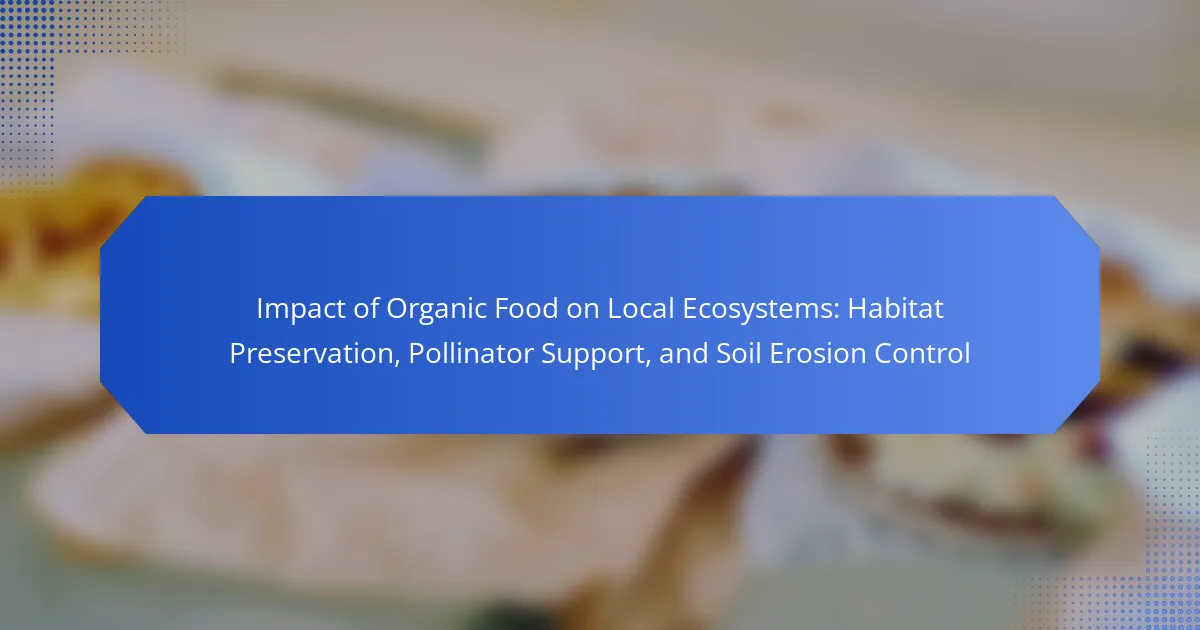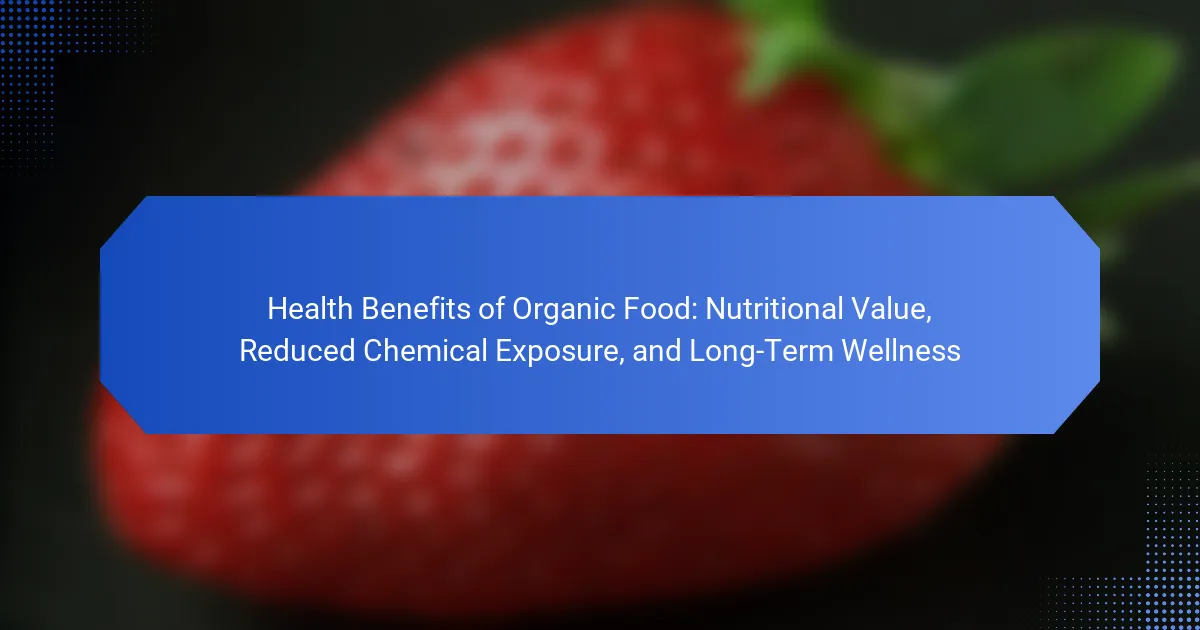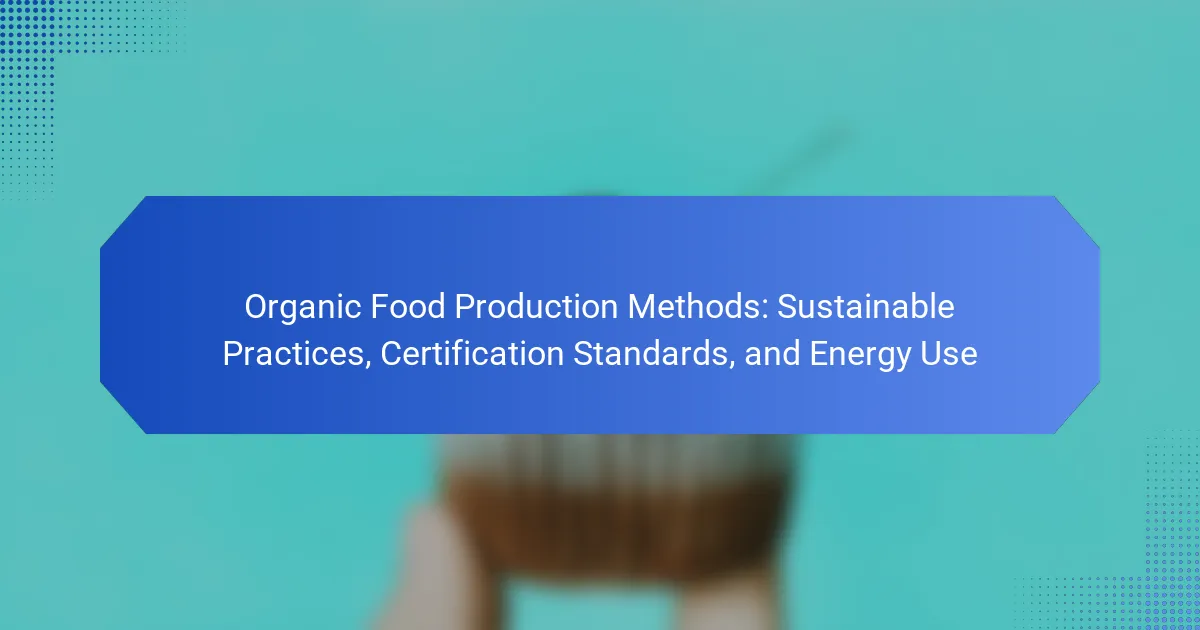The article focuses on the economic viability of organic farming, highlighting its favorable profit margins and increasing investment opportunities. Organic crops typically command a price premium of 20% to 100% over conventional crops, driven by rising consumer demand. The article discusses various risk management strategies essential for maintaining profitability, including crop rotation, diversification, and organic pest control methods. Additionally, it emphasizes the importance of establishing direct-to-consumer sales channels and obtaining organic certifications to enhance marketability and income stability. Overall, the content provides a comprehensive overview of best practices that contribute to sustainable and profitable organic farming.
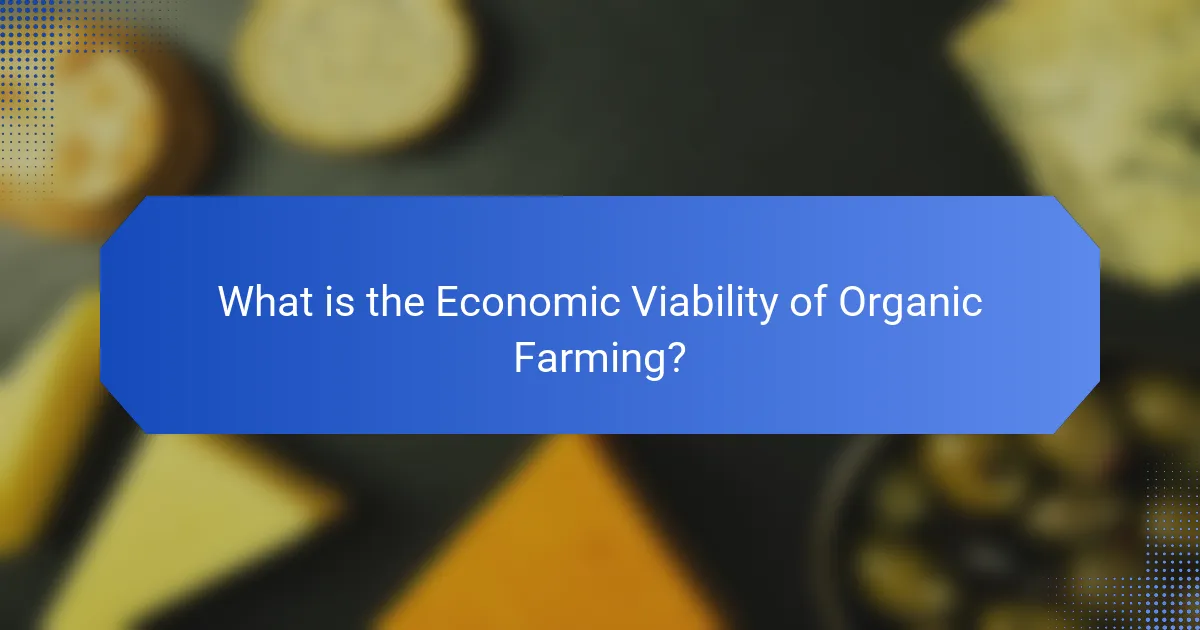
What is the Economic Viability of Organic Farming?
The economic viability of organic farming is generally considered favorable. Organic farming often yields higher profit margins compared to conventional farming. According to the USDA, organic crops can sell for 20% to 100% more than non-organic crops. This price premium reflects growing consumer demand for organic products. Additionally, organic farming can reduce costs associated with chemical inputs. Lower input costs can enhance overall profitability. Investment opportunities in organic farming are increasing as market demand rises. However, organic farming also involves certain risks, such as crop failure and market fluctuations. These factors must be managed to ensure long-term economic viability.
How is economic viability defined in the context of organic farming?
Economic viability in organic farming refers to the ability of organic farms to maintain profitability over time. This involves generating sufficient revenue to cover operational costs while ensuring sustainable practices. Economic viability is influenced by factors such as market demand for organic products, production costs, and access to resources. Research indicates that organic farms often achieve higher prices for their products compared to conventional farms. A study by the USDA found that organic produce can yield up to 20% more in profit margins. Additionally, effective risk management strategies can enhance economic viability by mitigating potential losses.
What key metrics are used to assess economic viability?
Key metrics used to assess economic viability include net present value (NPV), internal rate of return (IRR), and payback period. NPV calculates the difference between the present value of cash inflows and outflows. A positive NPV indicates that the investment is expected to generate profit. IRR represents the discount rate that makes the NPV of an investment zero. A higher IRR suggests a more attractive investment opportunity. The payback period measures the time required to recover the initial investment. Shorter payback periods are generally preferred, indicating quicker returns. These metrics collectively provide a comprehensive assessment of an investment’s financial feasibility.
How does organic farming differ from conventional farming in terms of viability?
Organic farming generally has higher viability due to its sustainable practices and market demand. Organic methods prioritize soil health and biodiversity, leading to long-term productivity. Studies show that organic farms can yield comparable outputs to conventional farms under certain conditions. Additionally, organic products often command higher prices, enhancing profit margins. The market for organic goods has been growing steadily, driven by consumer preference for healthier options. This trend indicates a strong investment opportunity in the organic sector. However, organic farming may require higher initial investments in certification and inputs. Overall, the economic viability of organic farming is supported by increasing consumer demand and potential for profitability.
What factors influence the profit margins in organic farming?
Profit margins in organic farming are influenced by several key factors. These factors include production costs, market demand, and pricing strategies. Production costs encompass labor, seeds, and organic certification expenses. Market demand for organic products can vary based on consumer preferences and trends. Pricing strategies involve setting competitive prices while ensuring profitability. Additionally, crop yield and pest management practices also play significant roles. According to the USDA, organic farms often achieve higher prices but may face higher production costs. Therefore, balancing these factors is crucial for maintaining healthy profit margins in organic farming.
How do production costs impact profit margins?
Production costs directly reduce profit margins in any business. When production costs increase, the amount left for profit decreases. This relationship is critical in organic farming, where input costs can be higher than conventional methods. For example, organic fertilizers and pest control can be more expensive. If these costs rise, farmers must either absorb the loss or increase prices. A study by the USDA found that higher production costs can lead to profit margins dropping by as much as 20%. Therefore, managing production costs is essential for maintaining healthy profit margins.
What role do market prices play in determining profit margins?
Market prices directly influence profit margins by determining the revenue a business can generate from its products. When market prices are high, profit margins tend to increase, assuming costs remain stable. Conversely, low market prices can compress profit margins, making it challenging for businesses to cover expenses. For instance, organic produce often commands higher prices due to consumer demand. This price premium can lead to significantly higher profit margins compared to conventional farming. Research indicates that organic farmers can achieve profit margins of 20% to 30% when market prices are favorable. Thus, fluctuations in market prices play a critical role in shaping the financial viability of organic farming ventures.
What investment opportunities exist in organic farming?
Investment opportunities in organic farming include land acquisition, organic seed production, and value-added products. Investors can purchase agricultural land to cultivate organic crops. Organic seed production is a growing sector due to increasing demand for organic produce. Additionally, creating value-added products, such as organic sauces or snacks, can enhance profit margins. The organic food market is projected to reach $320 billion by 2025, indicating strong growth potential. Furthermore, government grants and subsidies for organic farming are available, incentivizing investment. Sustainable practices can also lead to lower operational costs over time. Investing in organic farming aligns with consumer trends favoring health and sustainability.
What types of investments are most common in organic farming?
Common investments in organic farming include land acquisition, equipment purchase, and organic certification. Land acquisition is essential for establishing a farm. Equipment purchase often involves tractors, tillers, and irrigation systems. Organic certification is necessary to market produce as organic. Additionally, investments may include seeds and organic fertilizers. Research shows that organic farms can yield higher profits, attracting more investors. According to the USDA, organic farming has seen significant growth, indicating strong investment potential.
How can investors assess the potential return on investment in organic farming?
Investors can assess the potential return on investment in organic farming by analyzing key financial metrics. These metrics include profit margins, yield per acre, and market demand for organic products. Profit margins in organic farming can be higher than conventional farming, often ranging from 20% to 30%. Yield per acre for organic crops can vary but is typically lower than conventional methods, averaging about 10% to 20% less. However, the premium prices for organic produce can offset lower yields.
Market demand for organic products has been growing steadily, with the organic food market projected to reach $620 billion by 2024. Investors should also consider operational costs, which can be higher due to organic certification and labor-intensive practices. Conducting a cost-benefit analysis and reviewing case studies of successful organic farms can provide further insights. For instance, a study by the USDA found that organic farms can achieve returns on investment that are competitive with conventional farms when managed effectively.

How can risks in organic farming be managed?
Risks in organic farming can be managed through various strategies. Implementing crop rotation reduces pest and disease pressure. Diversifying crops enhances resilience against market fluctuations. Utilizing organic pest control methods minimizes chemical dependency. Regular soil testing improves nutrient management and crop yields. Developing a strong marketing plan ensures stable income. Building relationships with local suppliers secures reliable inputs. Investing in training for farmers enhances knowledge of best practices. These methods collectively contribute to sustainable and profitable organic farming practices.
What are the primary risks associated with organic farming?
The primary risks associated with organic farming include pest infestations, crop diseases, and market fluctuations. Pest infestations can significantly reduce yields, as organic methods often rely on natural controls that may not be as effective as chemical pesticides. Crop diseases pose a similar threat, as organic farmers have limited options for disease management. Market fluctuations can affect the price and demand for organic products, impacting profitability. Additionally, organic farming often requires more labor and can lead to higher production costs. Weather variability also presents risks, as organic farmers may have less access to irrigation and rely on rainfall. These risks can challenge the economic viability of organic farming operations.
How do environmental factors affect risk management in organic farming?
Environmental factors significantly impact risk management in organic farming. Weather patterns, such as droughts or excessive rainfall, affect crop yields. Soil quality determines nutrient availability and pest resistance. Biodiversity influences ecosystem balance and pest control. Organic farmers must adapt to these variables to minimize losses. For example, crop rotation can enhance soil health and reduce disease risk. Additionally, changes in climate can alter pest and disease dynamics. Understanding these factors helps farmers implement effective risk mitigation strategies. Research shows that resilient farming practices improve long-term sustainability and profitability.
What are the financial risks involved in organic farming?
Organic farming carries several financial risks. These include higher production costs compared to conventional farming. Organic inputs such as seeds and fertilizers often cost more. Additionally, organic farmers may face lower yields due to pest and disease challenges. Market prices for organic products can be volatile. Farmers may struggle to secure consistent buyers for their produce. Transition periods from conventional to organic can lead to temporary income loss. Lastly, certification costs can add financial burden. According to the USDA, organic farming can require significant upfront investment, impacting cash flow.
What strategies can be implemented to mitigate risks?
Implementing strategies to mitigate risks in organic farming includes diversifying crops, investing in insurance, and adopting sustainable practices. Crop diversification reduces dependency on a single crop, thereby minimizing losses from market fluctuations or crop failure. Insurance can protect against unforeseen events like natural disasters, providing financial stability. Sustainable practices, such as soil health management and integrated pest management, enhance resilience against pests and diseases. Research shows that diversified farms have up to 30% lower risk of income volatility compared to monoculture systems. These strategies collectively enhance the economic viability of organic farming by safeguarding profits and ensuring long-term sustainability.
How can diversification benefit organic farmers?
Diversification can benefit organic farmers by enhancing their economic stability and resilience. It allows farmers to grow multiple crops or raise different livestock, reducing reliance on a single source of income. This strategy mitigates risks associated with market fluctuations and crop failures. For example, if one crop fails due to pests or weather, other crops can still provide revenue. According to a study by the USDA, diversified farms often report higher profit margins. Additionally, diversification can improve soil health and pest management, leading to better yields over time. By cultivating various plants, farmers can promote biodiversity, which supports ecosystem services. Overall, diversification strengthens the economic viability of organic farming.
What role does insurance play in risk management for organic farming?
Insurance serves as a critical tool in risk management for organic farming. It protects farmers against potential financial losses due to unforeseen events. These events may include natural disasters, crop failures, or market fluctuations. By having insurance, organic farmers can mitigate the financial impact of such risks. This allows them to maintain stability and sustainability in their operations. Additionally, insurance can provide access to funding opportunities. Lenders often require insurance as a condition for providing loans to farmers. Overall, insurance enhances the economic viability of organic farming by reducing risk exposure.
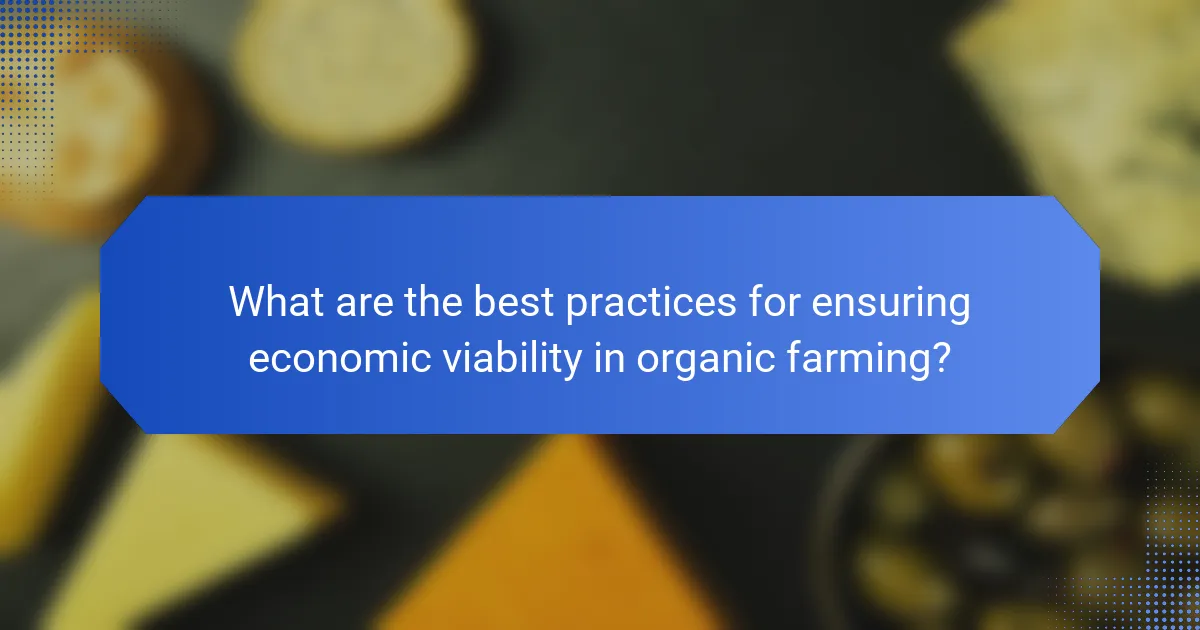
What are the best practices for ensuring economic viability in organic farming?
Implementing crop rotation is a best practice for ensuring economic viability in organic farming. Crop rotation enhances soil fertility and reduces pest and disease pressure. Diversifying crops can lead to higher yields and better market opportunities. Utilizing cover crops improves soil health and reduces erosion. Integrated pest management minimizes chemical inputs while maintaining crop health. Establishing direct-to-consumer sales channels can increase profit margins. Investing in organic certifications can enhance marketability and consumer trust. According to the USDA, organic farms often achieve higher price premiums compared to conventional farms, supporting economic sustainability.
How can farmers optimize their operations for better profit margins?
Farmers can optimize their operations for better profit margins by implementing precision agriculture techniques. These techniques utilize data analytics to enhance crop yields and reduce input costs. For example, using soil sensors can help farmers apply fertilizers more efficiently. This targeted approach can lead to a reduction in fertilizer costs by 20-30%.
Additionally, farmers can adopt crop rotation and diversification strategies. These practices improve soil health and reduce pest outbreaks, leading to higher yields. Studies show that crop rotation can increase yields by 10-20%.
Investing in technology such as drones for monitoring crop health can also enhance operational efficiency. Drones provide real-time data that allows for timely interventions, ultimately boosting productivity.
Moreover, establishing direct-to-consumer sales channels can improve profit margins. Selling through farmers’ markets or online platforms reduces reliance on intermediaries. This shift can increase profits by 15-30%.
Lastly, farmers should focus on sustainable practices. Implementing organic farming methods not only improves soil quality but also attracts premium pricing for organic products. Organic crops can sell for 20-100% more than conventional ones.
What techniques can be used to reduce production costs?
Techniques to reduce production costs include optimizing resource use, improving labor efficiency, and adopting technology. Resource optimization involves using inputs like water and fertilizers more efficiently. For instance, precision agriculture can minimize waste and enhance yield. Improving labor efficiency can be achieved through training and better management practices. This can lead to increased productivity and reduced labor costs. Adopting technology, such as automation and data analytics, can streamline operations. According to a study by the USDA, farms that implement technology report up to a 30% reduction in operational costs. These techniques collectively contribute to lowering overall production expenses in organic farming.
How can farmers effectively market their organic products?
Farmers can effectively market their organic products by utilizing direct-to-consumer sales channels. These include farmers’ markets, community-supported agriculture (CSA) programs, and online sales platforms. Engaging in social media marketing can also enhance visibility and attract customers. Clear labeling and certification of organic products build trust with consumers. Establishing partnerships with local restaurants and grocery stores can expand market reach. Educating consumers about the benefits of organic products is essential for differentiation. According to a report by the Organic Trade Association, organic food sales reached $61.9 billion in the U.S. in 2020, indicating a growing market. Effective marketing strategies can significantly increase farmers’ profit margins.
What resources are available for farmers looking to invest in organic farming?
Farmers looking to invest in organic farming can access various resources. Government grants and subsidies support organic transitions. The USDA offers programs like the Organic Certification Cost Share Program. Non-profit organizations provide educational resources and funding opportunities. The Sustainable Agriculture Research and Education (SARE) program funds innovative practices. Local extension services offer advice and training on organic methods. Online platforms provide market data and best practices. Research institutions publish studies on organic farming trends and profitability. Networking with local organic farming associations can also yield valuable insights and support.
How can farmers access financial assistance or grants for organic farming?
Farmers can access financial assistance or grants for organic farming through various government programs and private organizations. The USDA offers grants specifically for organic farming through the Organic Agriculture Research and Extension Initiative. Additionally, the Environmental Quality Incentives Program provides financial assistance for conservation practices that support organic farming. State agricultural departments often have their own grant programs for local farmers. Nonprofit organizations also provide grants aimed at supporting sustainable agriculture. Farmers should research these options and apply for funding that aligns with their specific needs and projects.
What educational resources are available to support organic farming practices?
Various educational resources are available to support organic farming practices. These include university extension programs that offer workshops and seminars on organic methods. Online platforms provide access to courses focused on organic farming techniques. Non-profit organizations often publish guides and manuals tailored to organic practices. Government agencies may offer resources like financial assistance programs for organic farmers. Research institutions conduct studies that are accessible to farmers for best practices in organic farming. Additionally, farmer cooperatives frequently share knowledge and resources among members. These resources help enhance the skills and knowledge necessary for successful organic farming.
What common challenges do organic farmers face, and how can they be overcome?
Organic farmers face several common challenges, including pest management, soil fertility, and market access. Pest management can be difficult due to the restrictions on synthetic pesticides. Farmers can overcome this by using integrated pest management (IPM) strategies, which combine biological control, habitat manipulation, and resistant varieties. Soil fertility is another challenge, as organic methods often rely on crop rotation and organic amendments. Implementing composting and cover cropping can enhance soil health and nutrient availability. Market access is also a significant hurdle. Farmers can address this by forming cooperatives or participating in farmers’ markets to reach consumers directly. According to the USDA, organic farming can yield higher prices, which can offset these challenges.
How can organic farmers adapt to changing market demands?
Organic farmers can adapt to changing market demands by diversifying their crop offerings. This allows them to meet consumer preferences for various organic products. Implementing sustainable practices enhances their market appeal. Engaging in direct-to-consumer sales channels increases their visibility and profitability. Utilizing data analytics helps them understand market trends and consumer behavior. Collaborating with local businesses can expand their distribution network. Participating in organic certification programs can improve consumer trust. According to the USDA, the organic market has grown significantly, indicating a strong demand for organic products.
What solutions exist for pest and disease management in organic farming?
Organic farming employs several solutions for pest and disease management. Integrated Pest Management (IPM) is a key strategy. IPM combines biological control, cultural practices, and mechanical methods. Crop rotation disrupts pest life cycles and enhances soil health. Beneficial insects, like ladybugs, naturally control pest populations. Organic-approved pesticides, such as neem oil, provide additional protection. Disease-resistant crop varieties reduce the likelihood of outbreaks. Regular monitoring helps identify problems early. These methods collectively contribute to sustainable pest and disease management in organic farming.
The main entity of this article is the economic viability of organic farming. The article examines the profitability of organic farming, highlighting that organic crops often yield higher profit margins compared to conventional farming due to increased consumer demand and price premiums. It discusses key metrics for assessing economic viability, factors influencing profit margins, and investment opportunities in the organic sector. Additionally, the article addresses risks associated with organic farming and offers strategies for effective risk management, ensuring long-term sustainability and profitability in organic agriculture.
